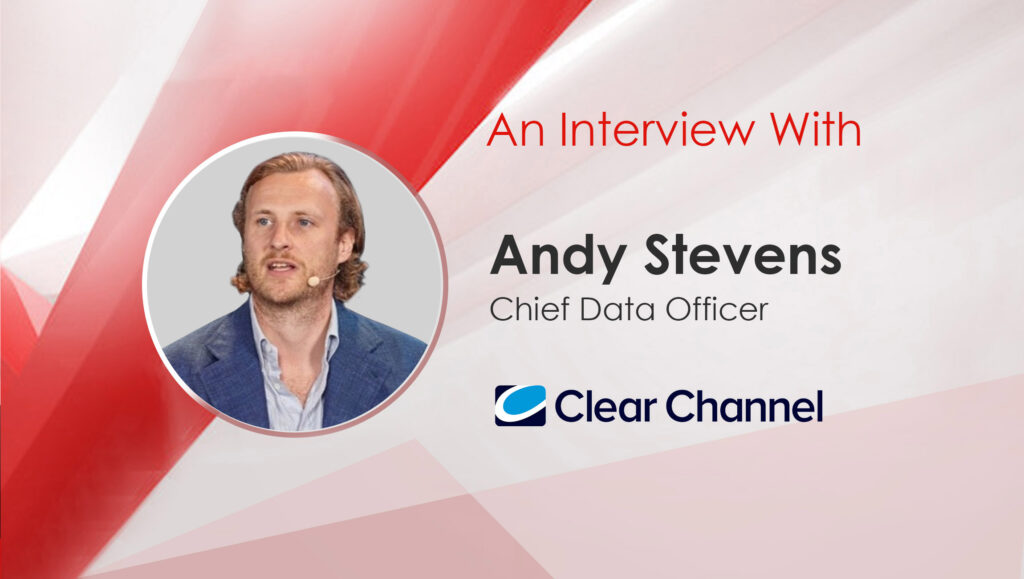Marketers and advertisers today need to tap into more of their real-time data to adjust even their OOH campaigns, Andy Stevens, Chief Data Officer at Clear Channel International explains more in this quick catch-up:
_________
Welcome to this MarTech Series chat Andy, tell us more about yourself and your new role as Chief Data Officer of Clear Channel?
I started my career in advertising about 20 years ago in the then emerging online ad space, primarily working with data, and saw some of the possibilities for data use in driving smart campaign planning. Then, six years ago I had the opportunity to shift into the Out-Of-Home industry with Clear Channel Americas.
Bringing some of the data use and methodologies I had learned from the digital space to OOH led to the launch of our product RADAR, which uses anonymised and aggregated third party mobile data to better understand the groups of audiences passing past Clear Channel’s OOH inventory, helping our customers choose the right panels, to reach the right groups of people, at the right time. We rolled the product out successfully in the US then decided to take it global in 2019.
The new role as Chief Data Officer signifies the new importance of data for the business. Data does not just support our value proposition but is increasingly integral to it, and I’m excited to realize the opportunity to make data a central component of our business strategy.
Marketing Technology News: MarTech Interview with Lisa Bennett, VP Marketing at Kaltura
Can you share a few thoughts on the changing scope of advertising in today’s marketplace and how OOH initiatives still play a key role in the whole ad mix today?
Increasingly, advertising is not just about delivering a message and providing value to the brands buying ads, but also about providing value to the consumers and achieving that in a non-invasive way. Advertising companies are now thinking more and more about how they can add to people’s experiences. By virtue of being a public medium, OOH has unique power. There is an intrinsic relationship with the space it occupies within communities, allowing companies like us to serve those communities by maintaining and developing those spaces – such as putting living roofs on bus shelters.
Our research has proven that trust is absolutely critical for brand consideration, and OOH is one of the most trusted mediums of advertising (The Moment For Trust, 2020). In an age of fake news where there is a vast amount of information that is hard to filter, the public nature of OOH means it can be relied upon to disseminate information ethically and accurately. When we use data, we should use it to serve communities as well as brands, and be mindful of the trust placed in us by ensuring we have a watertight data ethics policy, which is an important part of my role.
For marketers-advertisers looking to optimize their digital and offline ad mix, what top best practices come to mind?
My advice is, wherever possible, to forget about distinction between digital and offline. The idea of advertising in silos is becoming irrelevant and brands should be strategizing based on audience, not based on individual channels. The insights we have about groups of people and the way they behave are channel agnostic and the communication strategy should reflect that. Marketers can tap into that data ecosystem to deliver messages based on where customers are and when they are most receptive to messages, rather than delivering different messages per channel. They can plan based on when they can get the maximum value, instead of thinking in terms of channel silos.
A crucial part of strategy, which is sometimes forgotten is to consider the context in which advertisements are experienced. The audience – the ‘who’ – is important, but so is ‘when’ and ‘where’, and that is true of all channels. In OOH, context is inherent in the decision to advertise there, and our ability to be incredibly targeted with digital advertising should complement this. For example, advertising a luxury suitcase brand in an airport because the audience will be travellers. But those travellers will also be consuming mobile advertisements on the way to the airport, so the brand’s mobile strategy should be coordinated and targeted. The cumulative effect of someone seeing both the mobile and airport adverts is greater than the sum of its parts.
In your view, what are some of the tools and adtech/martech that can help drive ad initiatives in a crowded market?
There is a vast set of tools at marketers’ disposal, too vast to name. We’ve seen enormous value in those that bridge the gaps between the digital and physical worlds, making campaign planning and buying dynamic and seamless. For OOH, this means bringing it into the digital ecosystem and enabling marketers to tap into the vast amounts of digital data out there, to help drive a more informed and sophisticated decision-making and planning process. This was the thinking behind our tool RADAR. Another important objective is facilitating the OOH buying process itself and bringing that part into the digital ecosystem as well, so it’s just as easy and flexible as buying online ads. That is why we rolled out LaunchPad, to enable marketers to buy ads using the same data sets as digital campaigns and connect digital inventory to the same DSP buying platforms they’d use for digital advertising. By tapping into relevant real-time data, marketers can react immediately and adjust messaging on OOH platforms based on changing contexts – weather, breaking news, you name it. The result is a living, breathing, optimised platform that gets your message in the public realm.
Can you share a few examples of the most innovative ad experiences you’ve come across in the recent past?
We’ve been lucky enough to work with some incredible brands on some really innovative and creative ad experiences recently.
Around COP26 we supported a campaign for Conservation International that encouraged viewers to access natural soundscapes from all over the world by scanning QR codes displayed on digital billboards, amplifying nature’s voice at a critical time.
Earlier this year, Sony Pictures Releasing ran an amazing campaign on our OOH screens for Peter Rabbit 2 informed by real-time data from FindAnyFilm.com, showing the next available screenings at nearby cinemas. It was the first time cinema showtimes had been integrated into digital OOH ads.
A few adtech tools that you feel should be a part of every digital advertiser’s radar?
Funny you should mention RADAR…
But in all seriousness, there are far too many amazing tools out there to name off the top of my head. For me, the most useful tools are the ones that provide rapid information about the consumer response to your campaign and keep a finger on the pulse of the context in which your adverts are being shown. This can include social media monitoring, but there are tools out there that can take you further than that and have the ability to overlay that data onto where your customers – and importantly, potential customers – actually are, helping you to find the most effective way to reach them.
Some last thoughts, takeaways, digital marketing and martech-adtech tips and best practices before we wrap up!
The most important sentiment, or ‘best practice’, for me in martech and adtech right now is connecting existing sources and systems rather than building new ones for the sake of it. There is a vast ecosystem of data and insights out there, and by connecting them we can co-ordinate strategies and channels much more easily. At the end of the day, consumers don’t spend much time thinking about different data sources and channels, so the way we advertise shouldn’t reflect that. ‘Cross-channel marketing’, to me, is an increasingly irrelevant term. There is just ‘marketing’, and all channels are a means to delivering that.
Marketing Technology News: MarTech Interview with Melton Littlepage, Chief Marketing Officer at Outreach

Clear Channel Outdoor Holdings, Inc. is one of the world’s largest outdoor advertising companies with a diverse portfolio of approximately 500,000 displays in 22 countries across North America, Europe, Latin America and Asia, reaching millions of people monthly. It is comprised of two business divisions – Clear Channel Outdoor Americas (CCOA), the U.S. and Caribbean business division, and Clear Channel International (CCI).
Andy Stevens is the Chief Data Officer at Clear Channel International
Missed The Latest Episode of The SalesStar Podcast? Have a quick listen here!
Episode 110: Driving Sales-Marketing Unity with Chetan Chaudhary, Chief Revenue Officer at Scale AI
Episode 109: B2B Revenue Generation Tactics with Michelle Pietsch, VP of Revenue at Dooly.ai
Episode 108: Driving Sales Success with Jeremey Donovan, SVP of Revenue Strategy, SalesLoft
























